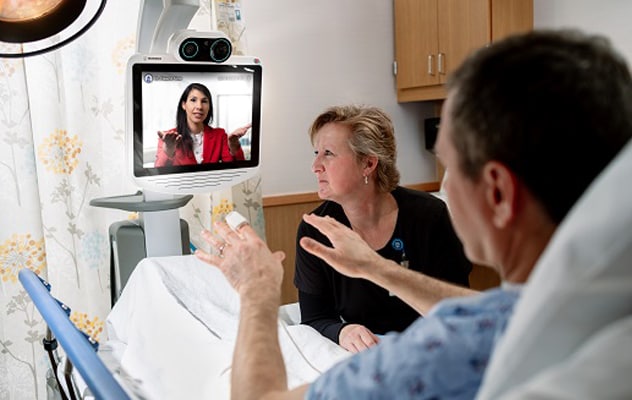July 21, 2021
Mayo Clinic's approach to telestroke spans the spectrum of patient care, providing people in remote areas the same level of stroke management achieved at Mayo's stroke centers.
"The morbidity and mortality outcomes in our telestroke network don't differ statistically from the outcomes for patients who present directly to one of Mayo Clinic's stroke centers," says Bart M. Demaerschalk, M.D., a neurologist at Mayo Clinic in Phoenix/Scottsdale, Arizona, chair of Stroke and Cerebrovascular Diseases and medical director of Telestroke. "We continue to demonstrate that stroke care can be capably provided for large numbers of patients within their home communities, with telestroke assistance."
 الاستفادة من الخبرة التخصصية عن بعد
الاستفادة من الخبرة التخصصية عن بعد
يوضح التقييم المحاكي لتطبيب السكتة الدماغية عن بعد استخدام مايو كلينك للتكنولوجيا المتطورة في مجال التطبيب عن بعد.
Established in 2007, Mayo Clinic telestroke performs roughly 1,500 consultations a year through more than 30 network sites and is significantly expanding its network coverage. In addition to Mayo Clinic's three main campuses and Mayo Clinic Health System, the network includes several partnering hospitals and health systems.
Twenty-five board-certified Mayo Clinic vascular neurologists serve in a pool across the network. "A telestroke neurologist is on duty at all times, with no competing responsibilities and with a backup system should there be a number of simultaneous emergencies," Dr. Demaerschalk says.
Evaluations are routinely performed by video. "We don't rely on phone calls. Video consultations allow us to perform a neurological exam, take a pertinent history and help determine during a highly time-dependent scenario what is the best treatment for the patient," says Stephen W. English, Jr., M.D., M.B.A., a vascular neurologist at Mayo Clinic in Jacksonville, Florida.
Among patients evaluated via Mayo Clinic telestroke:
- 32% receive intravenous recombinant tissue plasminogen activator medication
- 22% are identified as needing mechanical thrombectomy
- 65% are able to be treated in their community hospitals
"We are committed to supporting local emergency medicine physicians, nurses and other hospital staff, as well as patients and their families," Dr. Demaerschalk says. "But if a patient who is remotely evaluated at a community hospital needs a higher level of care, we are able in most cases to facilitate a transfer to a Mayo Clinic stroke center or to one of our partners' regional stroke centers. That ability to quickly transfer complex patients to a stroke center by ground or air is a key component of our telestroke network."
From ambulance to rehabilitation
Providing telestroke across the continuum of patient care requires multidisciplinary collaboration. Mayo Clinic neurologists routinely communicate with specialists in emergency medicine, hospital medicine, critical care medicine, neurosurgery and neuroradiology, as well as emergency medical technicians.
"We apply our team approach to patients in the emergency setting just as we do patients in the clinic," says Deena M. Nasr, D.O., a neurologist at Mayo Clinic in Rochester, Minnesota, and the site medical director for Mayo's telestroke core team in the Midwest. "Before a patient is transferred to another site, we are always involved in handing off the necessary information and making sure that the transfer site can carry the patient's care forward."
Patients transferred by ambulance can be remotely evaluated by a Telestroke vascular neurologist while en route. "Since starting our prehospital telestroke evaluations, we have reduced the average time between stroke onset and treatment delivery by about 10 minutes," Dr. Demaerschalk says.
Prehospital telestroke can also facilitate appropriate transfer for an individual with suspected large vessel occlusion. When a Telestroke specialist makes that determination, the patient can be taken directly to a comprehensive stroke center for mechanical thrombectomy.
"Recently adopted stroke guidelines specify that it's in the patient's best interest to bypass a hospital that can't perform mechanical thrombectomy if the additional delay to treatment is less than 30 minutes," Dr. English says. "Telestroke allows patients to be taken to the right hospital at the right time for the right treatment."
Once patients are admitted to network hospitals, Telestroke neurologists can consult with local physicians on those individuals' daily medical care. Telestroke is also used to remotely evaluate patients with suspected strokes while those individuals are hospitalized for other conditions.
"We know that there might be delays in recognizing the signs and symptoms of stroke while patients are in a medical or surgical ward," Dr. Demaerschalk says. "Telestroke can deliver expert emergency assessment to any patient within the hospital environment."
Before patients are discharged home or to rehabilitation centers, Telestroke neurologists can advise on follow-up therapy and care. "We have extended the virtual care concept beyond the emergency care environment to daily hospital management and transition back into the community," Dr. Demaerschalk says.
Dr. English notes that patients are generally receptive to video evaluation. "Stroke codes are disorienting for patients — and then someone wheels in a robot with a monitor and a doctor at the other end," he says. "But regardless of patients' ages or backgrounds, they really seem to appreciate the remote evaluation."
"The great strength of telestroke is the outreach it provides to people in areas without neurological expertise on site," Dr. Nasr says. "Mayo Clinic performs timely evaluations for patients who probably wouldn't get that without remote care."
For more information
Telestroke (stroke telemedicine). Mayo Clinic.